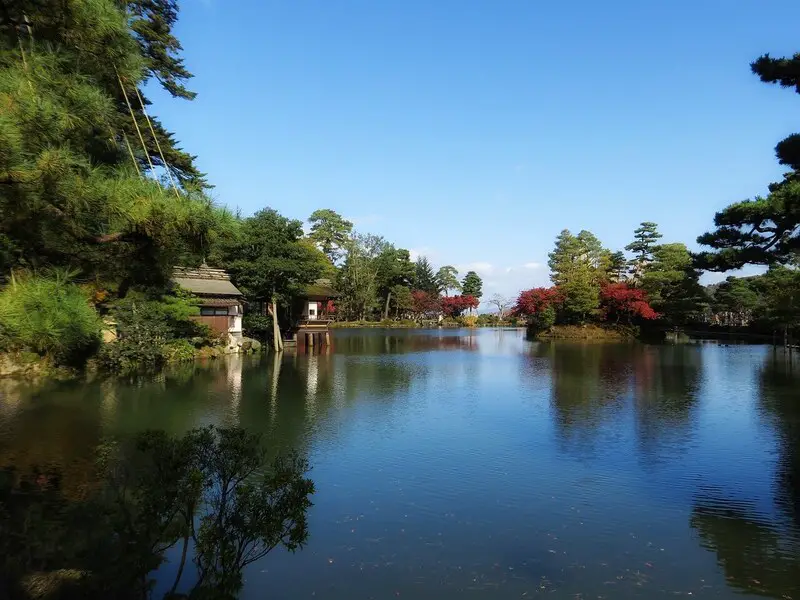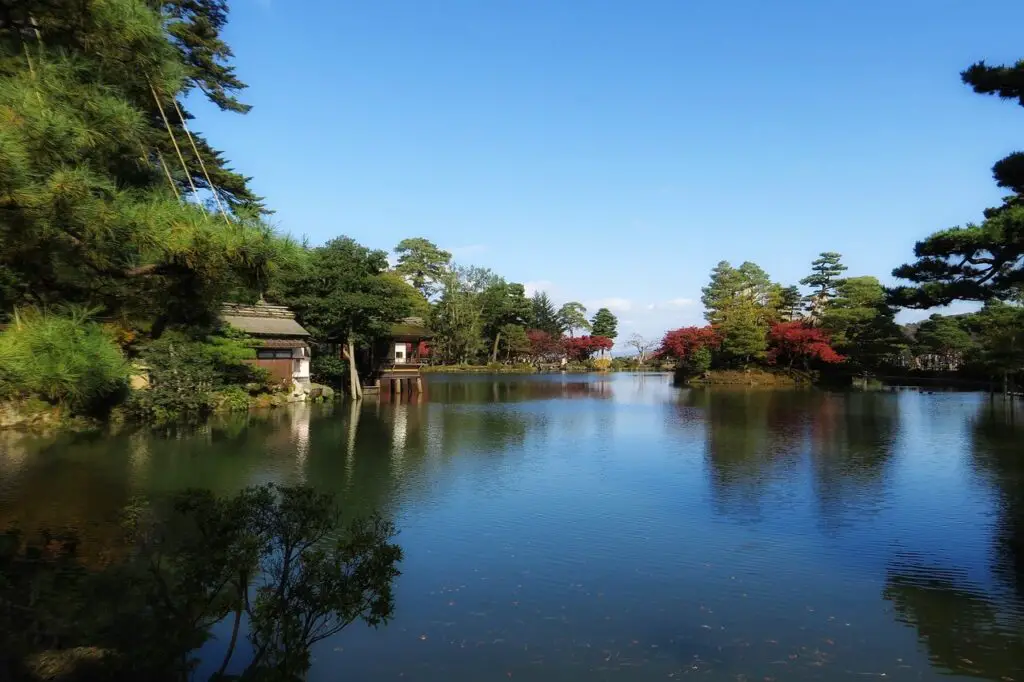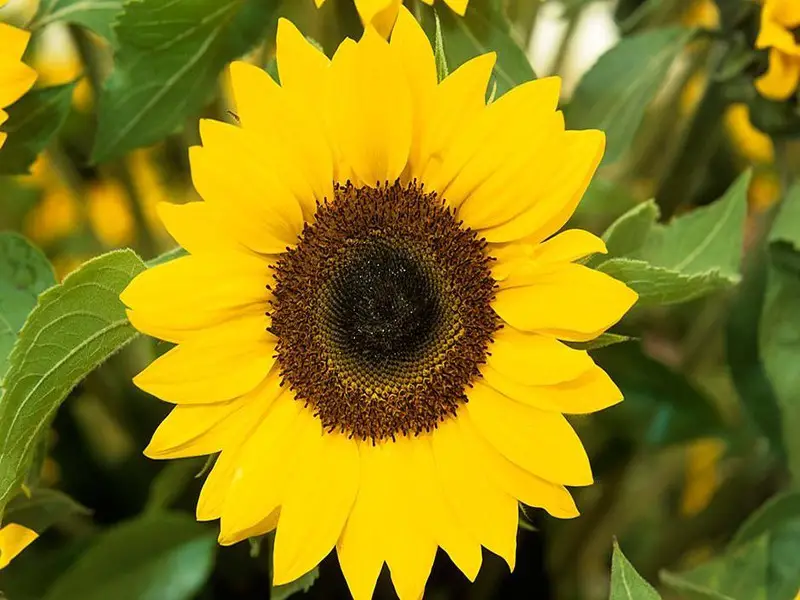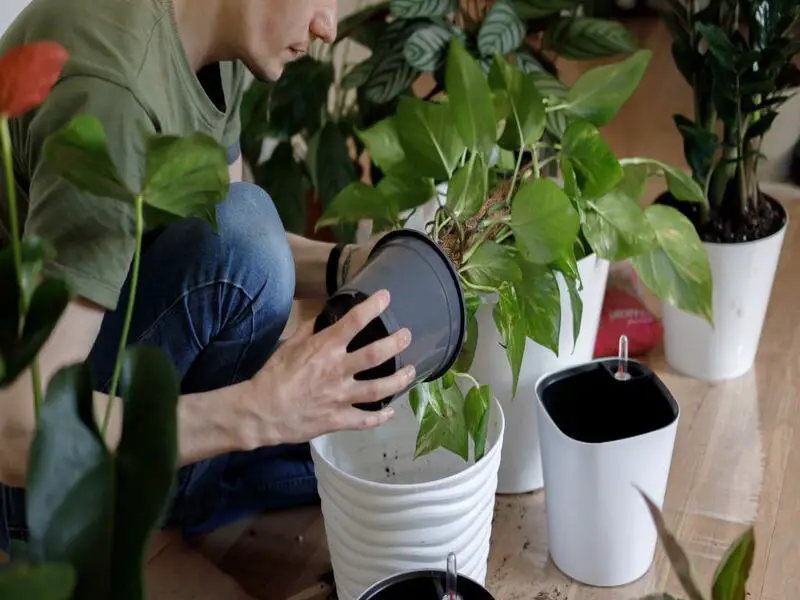Kenrokuen is a beautiful garden located in Kanazawa, Japan. It is considered one of the Three Great Gardens of Japan, along with Kairakuen and Korakuen. Kenrokuen was first created in the 17th century by the ruling Maeda family, who were known for their patronage of the arts and their love of nature. Today, the garden is open to the public and is a popular tourist attraction, known for its stunning scenery and historical significance.
History of Kenrokuen Garden
Kenrokuen Garden is a historic landmark in Kanazawa, Japan, known for its beautiful scenery and rich cultural heritage. The garden has a long and fascinating history that spans over three centuries, dating back to the Edo period.
The garden was first created in 1676 by Tsunanori Maeda, the 5th lord of the Maeda family who ruled over Kanazawa at the time. The name “Kenrokuen” was chosen to represent the six attributes that make up a perfect garden according to Chinese literature. These attributes are spaciousness, tranquility, artifice, antiquity, watercourses, and panoramas. The garden was designed to embody these six sublimities, and it quickly became one of the most celebrated gardens in Japan.
Over the years, the garden underwent many changes and additions. One of the most significant additions was the Kasumigaike Pond, which was completed in 1874. The pond is the centerpiece of the garden and is surrounded by breathtaking scenery, including teahouses, bridges, and islands. The pond is fed by the Sai River and is home to many species of fish, including carp and goldfish.
During the Meiji period, Kenrokuen Garden became a popular destination for tourists and was often used as a backdrop for photographs and artwork. The garden was also visited by many famous figures, including the poet Matsuo Basho, who wrote about the garden in his travelogue “Oku no Hosomichi.”
Despite suffering damage during World War II, Kenrokuen Garden was quickly restored to its former glory after the war. Today, the garden is a popular tourist destination and is considered one of the most beautiful gardens in Japan. In 2015, it was named one of the “Three Great Gardens of Japan” along with Korakuen Garden in Okayama and Kairakuen Garden in Mito.
Features of Kenrokuen Garden
Kenrokuen is a large garden covering an area of approximately 11 hectares. It is divided into several sections, each with its own unique features.
Kasumigaike Pond
The Kasumigaike Pond is one of the most remarkable features of Kenrokuen Garden. Covering an area of approximately 4 hectares, the pond is the largest body of water in the garden and serves as its centerpiece. The pond is located in the center of the garden, surrounded by a variety of scenic spots, including teahouses, bridges, and islands.
The pond was originally created as part of a renovation project initiated by the Maeda family in the 19th century. The renovation aimed to expand and enhance the garden’s existing water features, and the Kasumigaike Pond was added as part of this effort. The pond was designed to serve as a focal point for the garden, providing a serene and tranquil atmosphere that is perfect for relaxation and contemplation.
One of the most striking features of the pond is its clear blue water. The water is fed by the Sai River, which flows through the garden and supplies the pond with fresh water. The pond is also home to a variety of fish, including carp and goldfish. Visitors can enjoy feeding the fish and watching them swim in the crystal-clear water.
There are several small islands located within the pond, which are connected by bridges. These islands are home to various teahouses, where visitors can enjoy traditional Japanese tea and snacks while taking in the beautiful scenery. The teahouses are designed to blend in with the natural surroundings, providing a sense of harmony and balance that is characteristic of traditional Japanese gardens.
In the fall, the Kasumigaike Pond is particularly beautiful, as the leaves of the surrounding trees change color and reflect in the water. During this time, the pond is a popular destination for photographers and nature lovers alike.
Overall, the Kasumigaike Pond is a must-see attraction within Kenrokuen Garden. Its clear blue water, beautiful islands, and surrounding scenery make it a perfect place to relax and enjoy the natural beauty of Japan.
Kotoji-toro Lantern
The Kotoji-toro Lantern is a two-legged stone lantern that is considered one of the most iconic landmarks within Kenrokuen Garden. This lantern is a must-see attraction for anyone visiting the garden, and it has a fascinating history behind it.
The lantern was originally built during the Edo period by the 13th lord of the Maeda family, Toshitsune Maeda. Its name, “Kotoji-toro,” refers to the shape of the lantern, which is said to resemble the bridge of a koto, a traditional Japanese stringed instrument.
The Kotoji-toro Lantern is located on the edge of the Kasumigaike Pond, and it is surrounded by a beautiful landscape that includes maple trees, stone bridges, and waterfalls. The lantern’s reflection can be seen in the calm waters of the pond, adding to its stunning visual appeal.
The lantern is made of stone and features two legs that extend into the pond. It is illuminated at night, casting a warm glow over the surrounding area and creating a peaceful and serene atmosphere. Visitors can enjoy the lantern’s beauty during the day and at night, when it takes on a whole new level of enchantment.
The Kotoji-toro Lantern has been a symbol of Kanazawa and Kenrokuen Garden for centuries. It has inspired countless artists and writers, and it continues to capture the hearts and imaginations of visitors from around the world.
In addition to its visual appeal, the Kotoji-toro Lantern also has a deeper meaning. It is said to represent the balance between man and nature, a central theme in traditional Japanese gardens. The lantern’s legs extend into the pond, symbolizing man’s connection to the natural world and the importance of harmony and balance.
Overall, the Kotoji-toro Lantern is a must-see attraction within Kenrokuen Garden. Its unique design, stunning location, and rich history make it a true masterpiece of Japanese garden art.
Karasakinomatsu Pine Tree
The Karasakinomatsu Pine Tree is one of the most impressive sights within Kenrokuen Garden. It is an ancient tree that is over 400 years old and is considered one of the largest pine trees in all of Japan. The tree has become an iconic symbol of the garden, and it is a must-see attraction for visitors.
The Karasakinomatsu Pine Tree is located on a hill in the garden, and it stands at an impressive height of 13 meters. Its branches spread out widely, creating a beautiful canopy of green foliage that provides shade and shelter to visitors below.
Despite its age, the Karasakinomatsu Pine Tree remains healthy and robust, a testament to the care and maintenance that it has received over the years. The tree is pruned regularly to ensure that it maintains its shape and vitality, and it is carefully monitored for signs of disease or damage.
According to legend, the tree was named after the courtesan Karasaki, who is said to have visited the garden and rested beneath its branches. The tree has been a popular attraction ever since, drawing visitors from all over the world who are eager to see its impressive size and age.
Visitors to the garden can admire the Karasakinomatsu Pine Tree from a distance or get up close to it and take in its majesty. The tree is particularly beautiful in the spring, when it is covered in delicate pink blossoms that create a stunning contrast against the green foliage.
The Karasakinomatsu Pine Tree is a true natural wonder and a testament to the beauty and resilience of nature. It is a must-see attraction within Kenrokuen Garden and a reminder of the rich history and culture of Japan.
Yagao-tei Pavilion
The Yagao-tei Pavilion is one of the most famous and beautiful teahouses in Kenrokuen Garden. It is a historic building that dates back to the 17th century and was originally used by the Maeda family for tea ceremonies.
The pavilion is located on the shore of the Kasumigaike Pond and is surrounded by lush greenery and beautiful scenery. It is a perfect spot to relax and enjoy the peaceful atmosphere of the garden while sipping a cup of tea.
The Yagao-tei Pavilion is a typical example of a traditional Japanese teahouse. It is built in the sukiya style, which emphasizes simplicity and understated elegance. The pavilion is constructed from natural materials, including wood, bamboo, and paper, and features a thatched roof that adds to its rustic charm.
Visitors to the Yagao-tei Pavilion can participate in a traditional tea ceremony and learn about the history and culture of this ancient art form. The tea ceremony is a highly ritualized and symbolic practice that has been an integral part of Japanese culture for centuries.
The ceremony involves the preparation and serving of matcha, a finely ground powdered green tea, and typically lasts around 30 minutes. During the ceremony, guests sit on tatami mats and are served small sweets to offset the bitterness of the tea. The ceremony is a reflection of the Japanese cultural values of harmony, respect, purity, and tranquility.
The Yagao-tei Pavilion is a testament to the rich history and culture of Japan and is a must-visit attraction for anyone visiting Kenrokuen Garden. It is a perfect spot to relax and enjoy the beauty of the garden while experiencing a traditional Japanese tea ceremony.
How to Get to Kenrokuen Garden
Kanazawa is a city on the west coast of Japan and is easily accessible by train. The Hokuriku Shinkansen provides a fast and convenient way to get to Kanazawa from major cities like Tokyo and Osaka. Once you arrive in Kanazawa, you can reach Kenrokuen Garden by bus or on foot. The garden is located in the heart of the city, so it is easily accessible from most hotels and tourist attractions.
If you prefer to take a bus, you can take the Kanazawa Loop Bus and get off at the Kenrokuen Shuttle Bus stop. The shuttle bus operates every 15-20 minutes and takes you directly to the garden. Alternatively, you can take a taxi or walk to the garden if you are staying nearby.
Walking to Kenrokuen Garden is a great option if you want to explore the city and its surroundings. The garden is within walking distance of many hotels and tourist attractions, including the Kanazawa Castle and the Higashi Chaya District. The walk takes approximately 20 minutes from Kanazawa Station, but you can enjoy the scenic views of the city as you make your way to the garden.
In summary, getting to Kenrokuen Garden is easy and convenient, thanks to the city’s excellent transportation infrastructure. You can take the train to Kanazawa and then take a bus or walk to the garden from there.
Conclusion
Kenrokuen is a beautiful garden that is rich in history and cultural significance. It is a must-visit destination for anyone who is interested in Japanese gardens or who wants to experience the beauty of nature in Japan. With its stunning scenery and unique features, Kenrokuen is sure to leave a lasting impression on anyone who visits.





